Email marketing is a powerful tool to keep your customers engaged, and it’s far more cost-effective than retargeting ads if you already have their email addresses. With the right email flow, you can recover abandoned carts, drive repeat purchases, and nurture customer relationships—all without the high costs of paid ads. In this post, we’ll dive into the best practices for setting up effective abandoned cart email flows to help you convert lost sales and boost revenue. Let’s dive deep and discover how to create abandoned cart flow!
What is cart abandoned?
First, what is cart abandoned?
Cart abandonment occurs when a potential customer adds items to their online shopping cart but leaves the website without completing the purchase. This is a common issue for eCommerce businesses and can be influenced by unexpected shipping costs, complicated checkout processes, or distractions.
Reducing cart abandonment often involves optimizing the checkout experience, offering discounts or free shipping incentives, and sending follow-up emails to encourage customers to complete their purchases.
Why to use cart abandoned flow?
An abandoned cart flow is a series of emails sent to customers who added items to their cart but didn’t complete the purchase. These reminders can significantly reduce lost sales, as nearly 70% of online shopping carts are abandoned on average.
Here’s why you should use cart abandoned flow:
Recover lost revenue: It reminds potential customers about their unfinished purchase, which can lead to higher conversion rates and recovered sales.
Improve customer engagement: Personalized emails help re-engage customers, addressing their concerns or offering incentives like discounts or free shipping.
Reduce cart abandonment: By automating follow-up communications, you reduce the chances of losing sales due to distractions or hesitations.
Boost ROI: Cart abandonment emails typically have higher open and conversion rates compared to other marketing emails, making them a high-ROI tactic.
Provide convenience: Some customers simply forget about their carts, and this flow serves as a helpful reminder, improving their overall shopping experience.
Using a cart abandonment flow is a proven strategy for maximizing sales and keeping customers engaged.
How to create cart abandoned flow in Klaviyo?
If you’re using Shopify or BigCommerce, your store might already have abandoned cart emails enabled. However, Klaviyo offers greater customization and targeting than the default options on eCommerce platforms.
With Klaviyo, you can fully personalize email and SMS content, add multiple messages, and tailor the flow based on factors like cart value and more. Be sure to disable any default abandoned cart messages on your platform to avoid sending duplicate messages to customers.
With Klaviyo, you have two options for creating an abandoned cart flow: you can either use a pre-built flow from the Flows Library or create one from scratch yourself.
Create an abandoned cart flow from the flows library
After integrating your eCommerce store with Klaviyo, you’ll find several best-practice flows automatically added to the Flows Library, including a pre-built abandoned cart flow.
Depending on your integration, there may be different types of abandoned cart flows to suit various needs.
Most pre-built abandoned cart flows trigger based on the “Started Checkout” metric, which activates when a customer enters their information at checkout and moves to the next step.
However, some eCommerce integrations track the “Added to Cart” metric, which triggers when an item is added to the cart but no order is placed.
For BigCommerce, this metric needs to be set up manually. For Shopify, ensure that the “Track behavioral events” setting is enabled to use the “Added to Cart” metric and the corresponding pre-built abandoned cart flow.
If you want to use pre-built flows, follow these steps:
- In the Klaviyo dashboard, click on Flows in the left-hand navigation, then select Create Flow.

- You’ll see a list of available templates. For abandoned cart flows, go to Browse by Goal and choose Prevent Lost Sales.
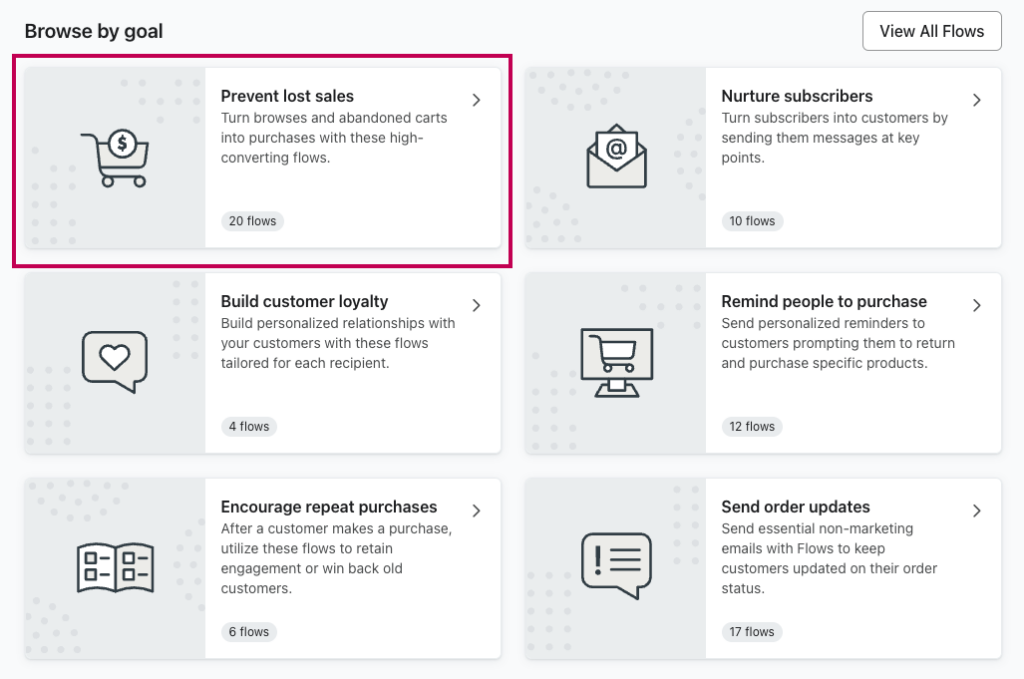
- Find and select the Abandoned Cart Reminder flow.
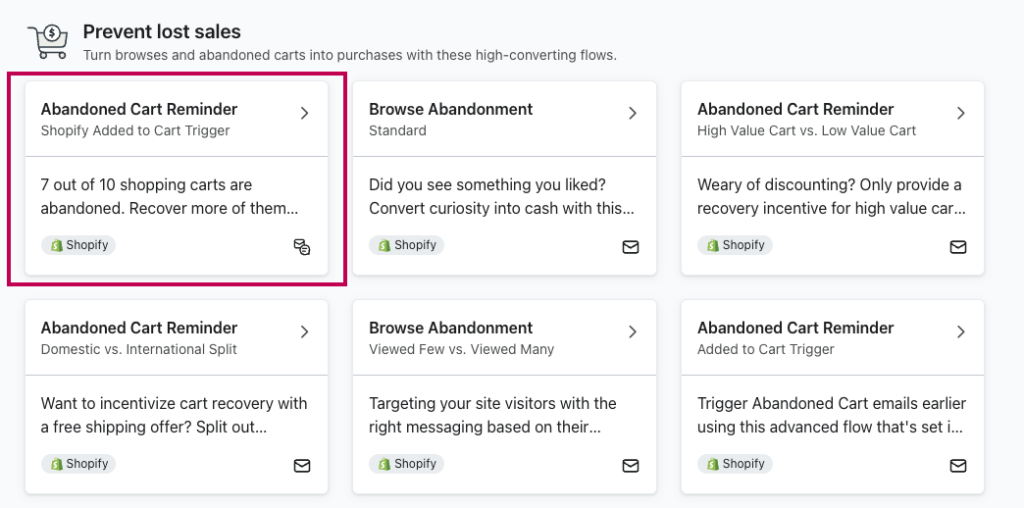
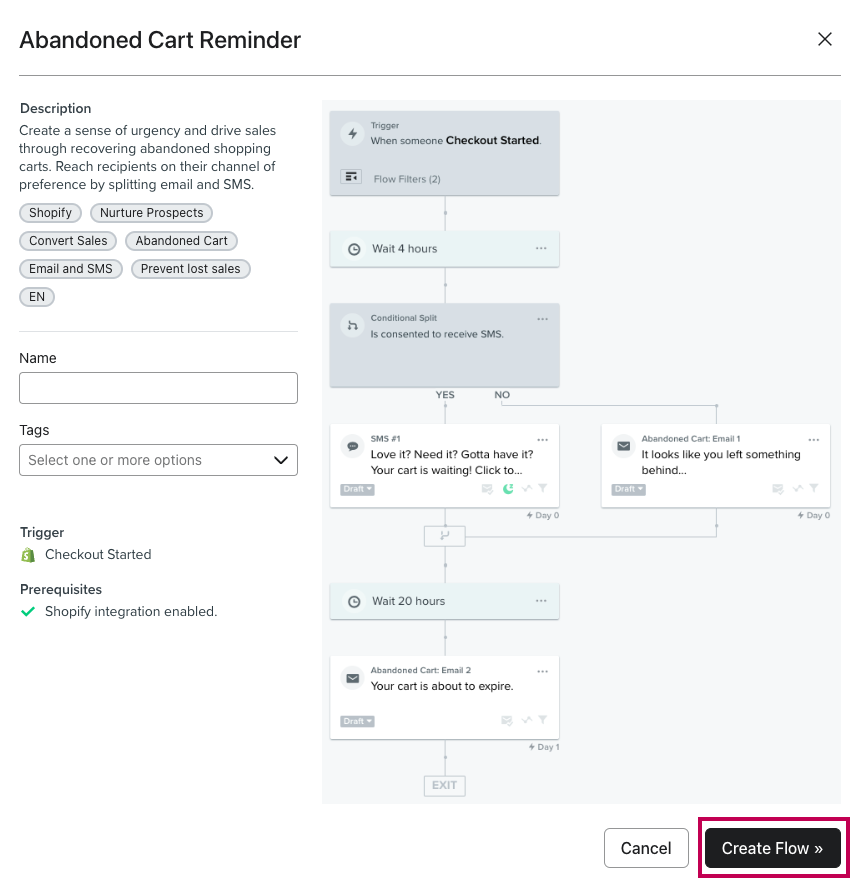
- Finally, create the emails you’d like to send, then click Publish to activate the flow.
Build an abandoned cart flow yourself
While it’s recommended to use a pre-built flow from the Flows Library, you can create your own abandoned cart flow from scratch.
However, you’ll need to manually add dynamic elements, which are covered later in this blog post. Follow these steps to build your custom flow:
1. Navigate to the Flows Tab: In the Klaviyo dashboard, go to the Flows section.
2. Create the Flow:
- Click the Create Flow button in the top right and choose Build your own.
- Name your flow (e.g., “Abandoned Cart”).
- Click on Create manually.
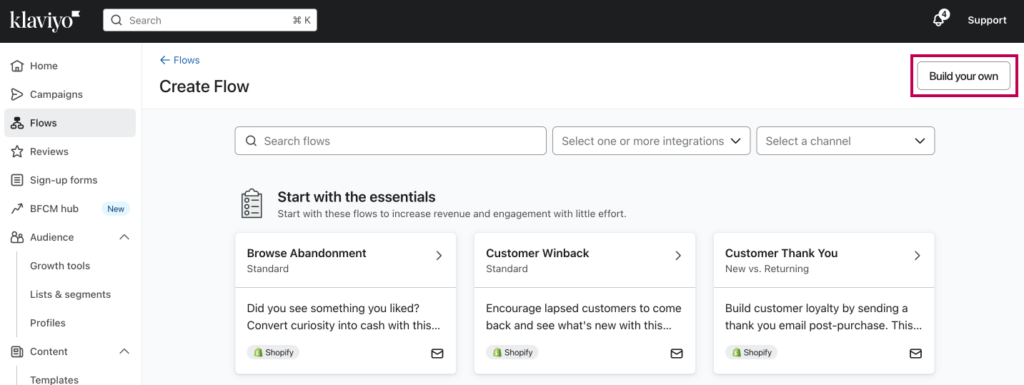
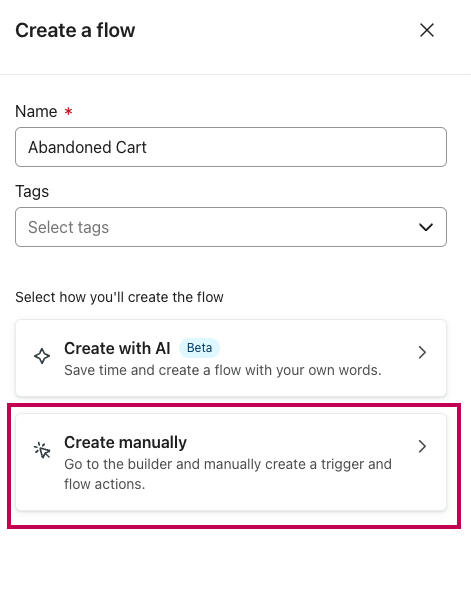
Set up the flow trigger and filters
The most common abandoned cart flow uses the Started Checkout event as the trigger. This tracks when a customer:
- Adds an item to their cart and proceeds to the checkout page.
- Fill in their contact information and proceed to the shipping page or reload the checkout page (depending on your integration). Contact information is required to create a profile.
- Does not complete the purchase, which marks the cart as abandoned.
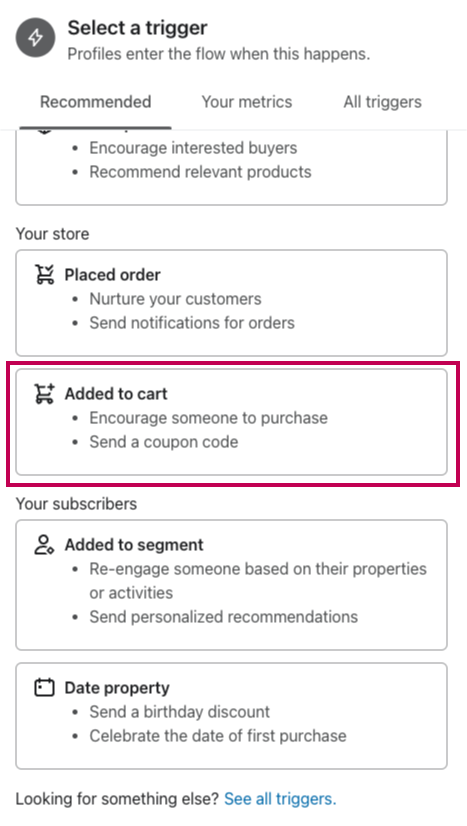
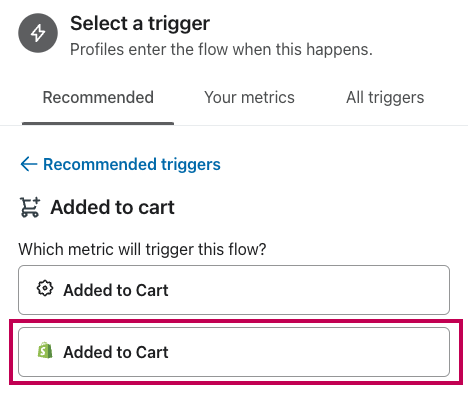
You’ll also need to add a filter to prevent customers who complete their purchase from entering the flow.
Configure the Trigger and Filters:
- Click on the Trigger.
- Select Profile Filters.
- Click Add a Flow Filter.
- Choose What someone has done (or not done).
- Set the filter to: Person has Placed Order zero times since starting this flow.
- Click Save.

This configuration ensures that customers who complete their purchase won’t continue through the flow, and anyone who places an order after receiving the first email won’t receive further emails.
How to edit the dynamic content block in Klaviyo
The dynamic content block in Klaviyo’s abandoned cart flow automatically shows the items a customer left in their cart. It pulls in key details like:
- Product image
- Title
- Quantity
- Price
If a customer has multiple items in their cart, the block will display each one. There’s also a Return to Cart button below the block that takes customers back to their cart.
You can customize how many items are shown by editing the block, and if you delete it by mistake, you can easily restore it from Klaviyo’s Flows Library.
Since the dynamic content is essential to abandoned cart emails, it’s important not to delete or overwrite it. Before making any changes, save the block so you can easily reuse it. If you already have a custom email template, you can drag the saved dynamic block into it.
The dynamic content is included automatically in Klaviyo’s pre-built flows, but you can tweak it if needed. If you’re building a flow from scratch, you’ll need to create the dynamic block yourself using Klaviyo’s dynamic variables. This can be tricky because each integration has its tags, so we recommend saving the block before making changes to ensure everything works smoothly.
Best practices for abandoned cart email flow
Timing is key when sending abandoned cart emails, and a well-structured sequence can greatly improve your chances of recovering lost sales. Start by sending the first email between 30 minutes and 1 hour after a customer abandons their cart.
This acts as a quick reminder, catching them while their intent to purchase is still fresh. Next, send a second email 24 hours later. This allows the customer some time to reconsider the items in their cart while keeping your brand in their mind.
To wrap up the sequence, consider sending a fourth and final email approximately 4 to 5 days after the initial cart abandonment. This last nudge helps maintain a thoughtful cadence—gently reminding the customer without overwhelming them.
That said, it’s important to monitor performance metrics closely. If you notice high unsubscribe or spam complaint rates, and the email isn’t generating meaningful revenue, it may be wise to exclude this step from your flow.
It’s also important to offer discounts strategically. Including a discount in the third email often works best, as customers may need that extra push. Offering a discount too early might diminish its effectiveness.
The ideal timing for your initial cart abandonment email can vary depending on your industry and the type of product you’re selling. While we typically see the strongest results when the first reminder is sent within 1 hour of abandonment, some brands find that a 2-hour delay actually performs better.
Ultimately, it comes down to understanding your customer and their purchase journey. Testing different send times will help you discover what works best for your audience and ensure you’re aligning your messages with their decision-making pace.
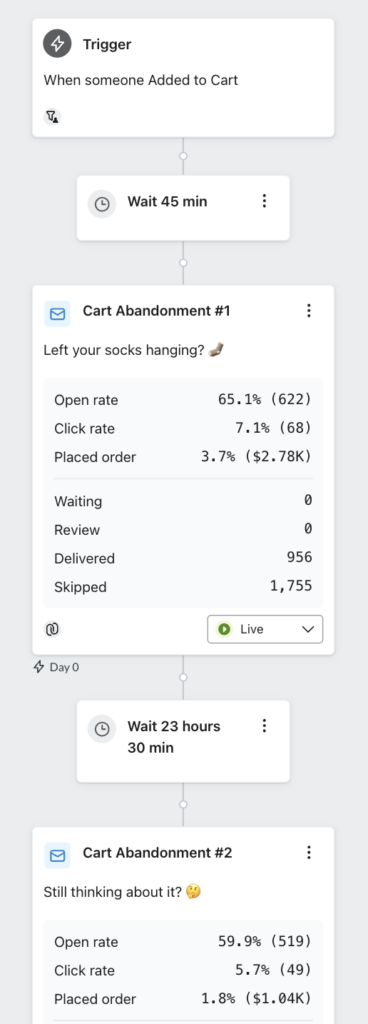
Smart Sending mistake
One issue we’ve discovered is that if someone visits your webshop for the first time, signs up for a discount through a popup or leaves their email elsewhere on the site, they’ll enter your welcome flow. However, if they add items to their cart and leave without purchasing, they might miss the first email in your abandoned cart flow. This can happen if you have the Smart Sending option enabled.
Smart Sending prevents customers from receiving multiple emails within a short window—specifically, within 16 hours of a previous send. While this helps reduce inbox fatigue, it can also delay critical messages.
In this case, the first—and most timely—reminder email (ideally sent within an hour of cart abandonment) may be skipped entirely. Instead, the customer might only receive the second message in the sequence, potentially a full day later, which can reduce the effectiveness of your recovery strategy.
While Smart Sending is a great way to prevent subscribers from receiving too many emails when multiple flows and campaigns are active, there are certain situations, like the abandoned cart flow, where it might be better to disable it. This ensures that key emails, such as the first abandoned cart reminder, are sent on time.
Cart abandonment flow benchmarks
When done right, cart abandonment emails are one of the highest-performing flows in any ecommerce strategy.
On average, cart abandonment emails see open rates between 40–50%, click rates around 8–12%, and placed order rates of 4–6%.
That’s a strong return for a single message triggered by customer behavior. These benchmarks make it clear: a well-timed, relevant reminder can meaningfully recover revenue that would otherwise be lost.
Of course, performance varies by industry, product type, and audience—but with thoughtful testing and optimization, many brands are able to exceed these averages and turn abandoned carts into loyal customers.
Summing Up
In this post, we covered the best practices for abandoned cart email flows, focusing on the importance of timing and how to use discounts effectively. A well-timed sequence of emails can help recover lost sales, with the first email sent 15 minutes after abandonment.
By fine-tuning your flows, you can create a customer-friendly experience while improving your chances of recovering abandoned carts and driving sales.
And don’t forget—Lebesgue: AI CMO integrates seamlessly with Klaviyo, where you can track overall purchases and revenue. Plus, with Lebesgue, you can gain valuable insights into your competitors’ email strategies, seeing exactly what emails they send and when.



